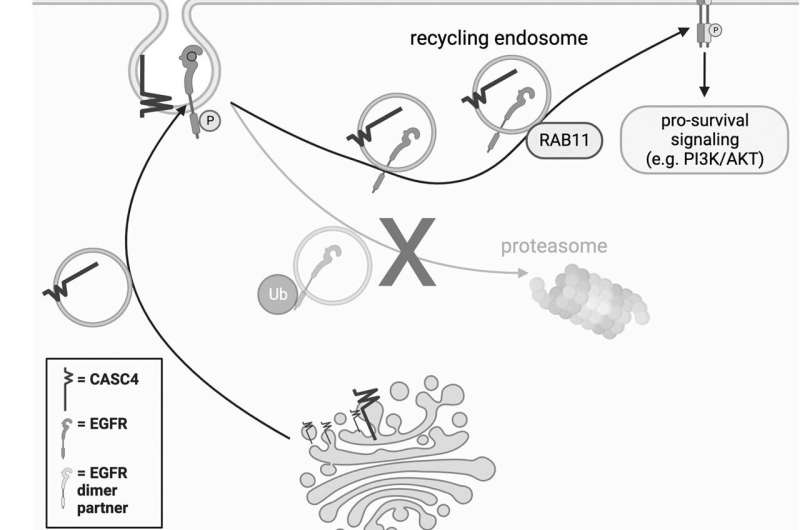This article has been reviewed according to Science X's editorial process and policies. Editors have highlighted the following attributes while ensuring the content's credibility:
fact-checked
trusted source
proofread
CRISPR study lays groundwork for overcoming ovarian cancer

A team of researchers at the University of Colorado Anschutz Medical Campus has gained attention for their work on rethinking ovarian cancer disease progression and treatment. Equipped with highly advanced technology, they are making inroads in rendering the most lethal cancer of the female reproductive system less deadly.
The American Cancer Society predicts that more than 12,000 women in the United States will die from ovarian cancer this year alone.
"Ovarian cancer progresses with only vague symptoms, leading to delayed diagnosis," said Lindsay Brubaker, MD, a gynecologic oncologist and an assistant professor in the Division of Gynecologic Oncology in the Department of Obstetrics and Gynecology at the University of Colorado School of Medicine (SOM).
Brubaker collaborates closely with ovarian cancer biologist, Benjamin Bitler, Ph.D., an associate professor in the Division of Reproductive Sciences, to better understand drivers of progression and chemoresistance in ovarian cancer.
"The vast majority of patients who are diagnosed with a high-grade serous carcinoma are diagnosed at an advanced stage, and most cancers will recur," Brubaker said of the most common subtype, which predominantly originates in the fallopian tubes, rather than the ovaries.
With high-grade serous carcinoma, cells found at the end of the fallopian tube in the fimbriae—finger-like projections directly next to the ovaries—detach from the epithelium and travel to different areas of the body, including the ovaries and abdominal cavity. When or how this occurs is still an area of active research.
In 2019, Brubaker and Bitler took an unbiased, genome-wide approach with CRISPR (clustered regularly interspaced short palindromic repeats)/Cas9 gene-editing technology and identified critical drivers of the disease—several of which were novel and had never been associated with ovarian cancer. The results of this genome-wide experiment have set the foundation for future experiments and brought the researchers one step closer to unlocking a better understanding of the disease.
Since then, the researchers have followed up on significant genes that emerged from the CRISPR study to understand better the mechanisms governing ovarian cancer and to develop treatments.
One of the top genes they identified was CASC4, but very little was known about this gene. In a new study, published in November in Cancer Gene Therapy, the Bitler Lab showed that high CASC4 expression is associated with poor clinical outcomes in high-grade serous carcinoma.
Mechanistically, they found that CASC4 helps cancer cells evade death both during disease progression and chemotherapy treatment. Their work suggests that CASC4 may one day be used as a novel biomarker for detecting earlier stages of the disease and improving chemotherapy efficacy.
In addition, the researchers have used the results from the CRISPR study to develop inhibitors that target novel cancer genes. Last year, they published another study, in Expert Opinion on Therapeutic Targets, in which they designed a peptide that blocks CBX2, a protein that promotes ovarian cancer progression and chemotherapy resistance. The peptide successfully inhibited tumor progression in vitro and in vivo.
Currently, Brubaker and her team are attempting to further improve the efficacy of the peptide, with the goal of using it in future clinical trials.
"All of these projects were grown out of the initial CRISPR paper," said Bitler. The progress they have made "would not have been possible without (Brubaker's) foundational work," he said.
"We are very fortunate here at the University of Colorado to have access to an incredible range of expertise and technology," Brubaker said, attributing much of her team's success to CU Anschutz's collaborative environment and world-class resources on campus, such as the Functional Genomics Shared Resource.
Next up: Addressing chemotherapy resistance
According to Brubaker, ovarian cancer is typically treated with a combination of surgery and chemotherapy; however, over time, the tumor cells develop resistance to chemotherapy, particularly drugs that are platinum-based.
"Our focus has become trying to understand what drives chemoresistance in high-grade serous carcinoma and how can we target those pathways and re-sensitize tumor cells to chemotherapy," she said.
Brubaker's team plans to develop new drugs and test existing drugs that may function as a new, targeted, anti-cancer therapy, she said. Traditional chemotherapy has the potential to be quite toxic. The hope is to find targeted therapies that will keep the cancer at bay while also improving the quality of life for the patient, Brubaker said. Brubaker, Bitler and the Bitler Lab are committed to better understanding high-grade serous carcinoma and identifying new therapeutic options.
More information: Jaidev Bapat et al, CASC4/GOLM2 drives high grade serous carcinoma anoikis resistance through the recycling of EGFR, Cancer Gene Therapy (2023). DOI: 10.1038/s41417-023-00703-1
Lindsay W. Brubaker et al, Novel chromobox 2 inhibitory peptide decreases tumor progression, Expert Opinion on Therapeutic Targets (2023). DOI: 10.1080/14728222.2023.2218614



















